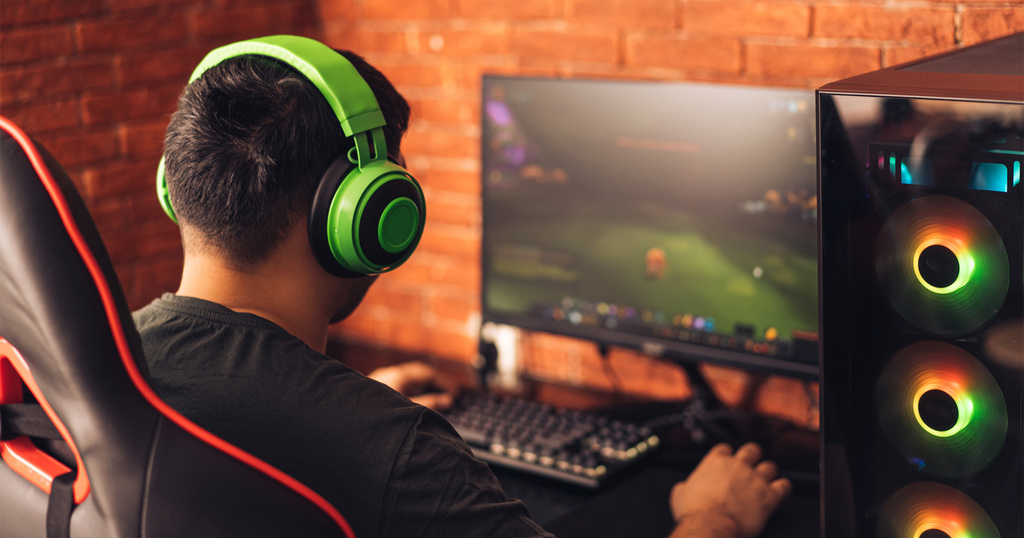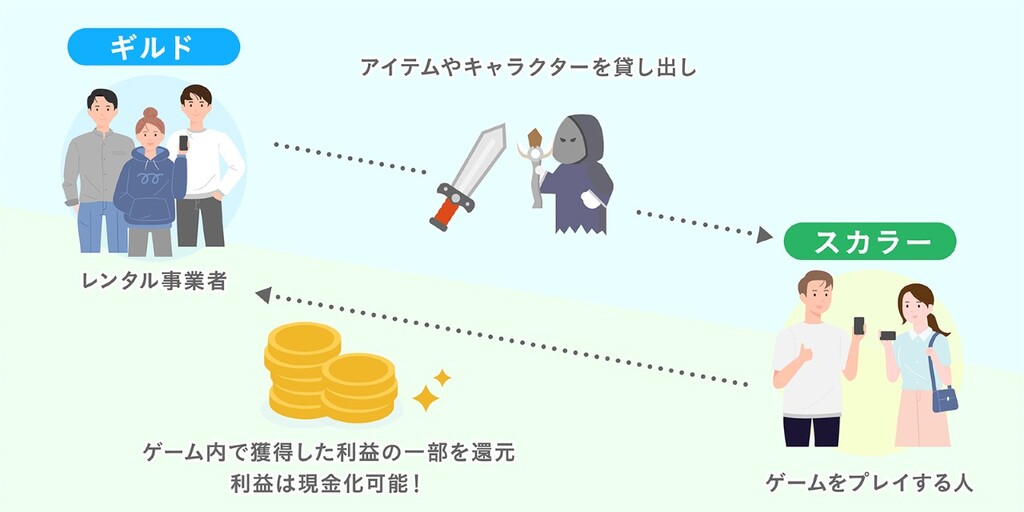Note: This website was automatically translated, so some terms or nuances may not be completely accurate.
GameFi: Play and Earn. The new business possibilities led by games leveraging NFT technology.
In recent years, the existence of people earning money through games, such as professional e-sports players, has been gaining attention. A system called "GameFi" that allows people to earn money simply by playing games, even without special skills, is attracting intense global interest. GameFi is a system that uses blockchain and NFT (Non-Fungible Token) technology to reward game players. In emerging economies like Southeast Asia and the Middle East, some people are even making a living through GameFi.
This article explores the future potential of GameFi from the perspective of "Can the spread of GameFi change the revenue structure of the gaming industry?" It's recommended not only for those who want to know the latest trends in the gaming industry or are wondering "What is GameFi?", but also for anyone seeking business insights from the latest NFT business trends, beyond just the gaming sector.
Anyone Can Earn While Playing Games! Why GameFi is Gaining Global Attention
There have always been ways to earn money through gaming, such as professional gamers winning prizes in esports or content creators streaming gameplay. However, these methods required exceptional skills or talent, like being an outstandingly skilled player or having a charismatic gamer persona with a dedicated fanbase.
But now, a system is emerging that allows people to earn money from games even if they aren't skilled enough to go pro or don't have a unique personality that attracts fans. That system is "GameFi." GameFi is a portmanteau of "Game" and "Finance" or "DeFi (Decentralized Finance)." It refers to a mechanism, built on blockchain and NFT technology, that rewards players.
Using NFT technology, in-game items and characters gain original value, enabling their trade or conversion into cryptocurrency. Furthermore, NFT items, whose uniqueness is proven, retain their value even after the service ends—unlike traditional games. Additionally, the inherent nature of blockchain technology makes it difficult for fraud, such as data tampering, to occur, adding to its appeal. Due to these characteristics, games utilizing GameFi are sometimes called "NFT games," "blockchain games," or "P2E (Play to Earn) games."
GameFi is rapidly gaining attention globally, with player populations growing particularly in Asian countries, India, the Middle East, and beyond. In emerging economies, players are actually earning enough through NFT games to cover living expenses or support their families.
Some games already boast millions of users, and startups and venture capital funds are continuously entering the GameFi industry. Domestically, major internet companies have established subsidiaries related to NFT games, and major game developers are reportedly considering entering the space. For players, the low barrier of "being able to do it while playing games" and the potential for monetary incentives suggest further widespread adoption is anticipated.
How Do Players Earn in NFT Games? GameFi's Two Business Models

As GameFi expands globally, let's now examine its business models in detail. GameFi primarily operates through two models: the "P2E (Play to Earn) Model" and the "Scholarship Model."
In the first "P2E Model," players earn NFTs as rewards for completing in-game missions. These rewards include not only cryptocurrency itself but also points usable within the game and NFT items.
Leveraging the unique, irreplaceable nature of NFTs, rewards earned in-game can also be traded. However, issues similar to RMT (Real Money Trading) can arise, such as rare items being traded for high prices. Incidentally, RMT refers to the act of buying or selling rare in-game items or leveled-up character accounts using real-world currency, rather than in-game currency or items. In Japan, this activity risks violating gambling laws and is prohibited in most games.
To address this issue, the second model, the "Scholarship Model," was created. This model allows players to rent NFT items or characters developed by other players. Players who rent items to play are called "Scholars." Scholars pay a portion of the rewards they earn to the rental provider, the "Guild." Guilds are operated by decentralized autonomous organizations ( DAOs ), which lack a central authority. The key feature of the Scholarship model is this mutually beneficial revenue structure between Guilds and players.

For example, a popular NFT game originating in Vietnam experienced explosive growth after adopting the scholarship system. Games featuring rare items that provide a competitive advantage can deter new players, who might hesitate to start, anticipating it would take too long to catch up with existing players. However, this game successfully lowered that barrier and increased its player base through its rental system.
While NFT games are gaining popularity, particularly in emerging markets, some point out that they remain less mature than traditional online games in terms of quality aspects like storytelling and gameplay. However, as mentioned earlier, major game companies are increasingly entering the GameFi space, and talented individuals, such as developers, are moving to NFT game development vendors. In the near future, we can expect evolution toward richer content incorporating the latest technologies, such as open-world games allowing free play across vast, interconnected fields, games offering immersion through realistic graphics and sound, and VR-enabled games.
The Potential for Japan to Become a "GameFi Powerhouse"

Based on the above, let's examine GameFi's future potential.
Considering the number of smartphone gamers and their per-capita spending, GameFi—which emerged as a mechanism to generate new financial value—is expected to see its market size grow alongside the development of NFT games. According to the "Famitsu Mobile Game White Paper 2021," the global game content market has expanded rapidly in recent years, with Asia recording particularly sharp growth rates. In Japan, influenced by the stay-at-home trend during the pandemic, the domestic game market surpassed ¥2 trillion in 2020. The domestic gaming player population reached 52.73 million, an approximately 110% increase year-on-year. Given Japan's large number of game developers and players, it is highly plausible that Japan could become a major GameFi powerhouse in the future.
While GameFi holds promise for future growth, challenges exist for its full-scale adoption. In Japan, the main challenges are likely the following two points:
1. NFT implementation is cumbersome
Complex procedures are required, such as opening dedicated accounts and purchasing cryptocurrency wallets.
2. Incomplete legal framework for NFTs
Legal frameworks concerning NFTs, such as ownership and copyright, are insufficient. Activities like reselling items obtained in-game or paid gacha systems (mechanisms for randomly acquiring in-game items) could potentially constitute gambling offenses. Additionally, free distribution campaigns for NFT-based game items may risk violating the Prize Display Act.
Overcoming these barriers will likely be key to developing NFT games in Japan.
The Potential of NFT Business Seen in the GameFi Ecosystem
Now, let's examine how GameFi could potentially transform the gaming industry's mechanisms and ecosystem (the industry structure for monetization) in the future. First, let's look at the ecosystem surrounding GameFi.
The ecosystem centered around the two models mentioned earlier—"P2E" and "Scholarships"—features various layers spanning the entire value chain, from upstream to downstream. Some businesses specialize in a single layer, while others operate across multiple layers. Here, we introduce related businesses categorized into the following three layers:
1. Upstream Layer
Businesses that provide the infrastructure necessary for developing NFT games, such as blockchain platforms, development platforms, and API providers for developers.
2. Middle Layer
Businesses that develop the NFT games themselves.
3. Downstream Layer
Businesses providing services to game development companies. Examples include "guilds" operating scholarship programs, "launchpads" organizing platforms for new cryptocurrency projects to raise funds, and "aggregators" consolidating multiple NFT games onto a single platform.
GameFi, which combines gaming and finance elements, is not merely a superficial change where "a system to earn money through games has emerged." As seen in how guilds in scholarship programs are decentralized, flat, distributed organizations aiming for profit-sharing among all stakeholders, the GameFi trend itself aligns with the context of " Web3.0," which promotes the democratization of the internet.
The fundamental shift in the values underpinning the gaming industry may spread throughout the entire sector as GameFi permeates. This transformation could extend far beyond game companies' ecosystems, encompassing upstream, midstream, and downstream players—companies developing user services, those placing ads within games, and firms planning and executing in-game events—and potentially engulf peripheral industries and even cross-sector businesses.
Indeed, a new trend linking the real world and the game world has emerged. In 2020, for example, a popular artist held a live concert within an online game, attracting over 10 million simultaneous participants. Other popular trends include live events featuring voice actors portraying game characters and collaboration merchandise between game characters and convenience stores. In-game events and communication will increasingly link with the real world. New developments may emerge, such as game items and real-world products sitting side-by-side on store shelves.
Furthermore, beyond GameFi, NFT-related businesses are continuously emerging in recent years. While many might think of NFT applications like the once-trending NFT art—the buying and selling of digital content—as the primary use case, initiatives leveraging NFTs are now starting across a much broader range of fields. For instance, NFTs can prove that a digital item is "one-of-a-kind," enabling their use for guaranteeing ownership, verifying the authenticity of goods or tickets, and preventing tampering with important documents. In Japan, efforts to tokenize real estate as NFTs are already underway to make transactions fairer and smoother. Furthermore, there are movements to tokenize items related to traditional culture, such as bonsai and temple stamps (goshuin).
The rise of GameFi can be seen as a result of this burgeoning NFT business landscape. Just as "games × NFTs" realized GameFi, we can expect new businesses incorporating NFTs to expand into even more diverse genres going forward.
GameFi, utilizing NFTs and blockchain technology, is underpinned by values and mechanisms aligned with the Web3.0 context, such as decentralized flat organizational structures and profit-sharing ecosystems. While NFT games are currently particularly popular in emerging markets like Southeast Asia, there is significant potential for GameFi to spread in Japan as well, given its major game developers and large player base. Furthermore, as exemplified by GameFi, NFTs hold diverse business possibilities. Keeping abreast of the latest trends may offer new insights for future business endeavors.
To learn about trending terms like "move to earn," please also refer to this resource.
The information published at this time is as follows.
Was this article helpful?